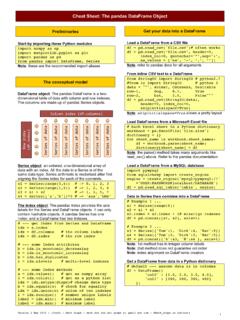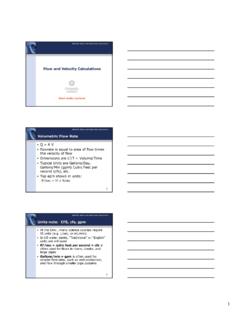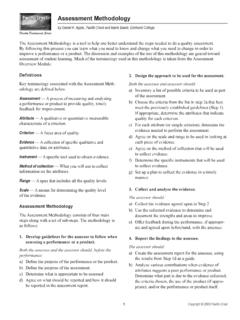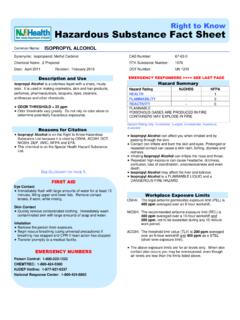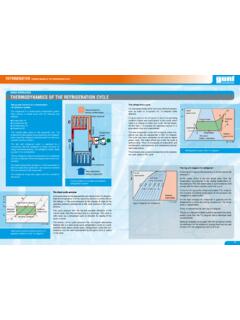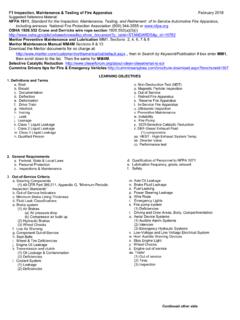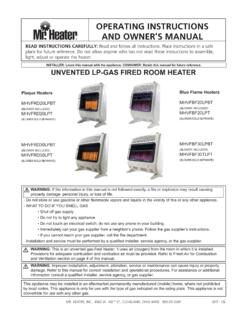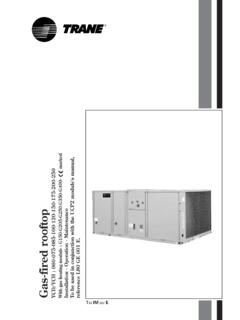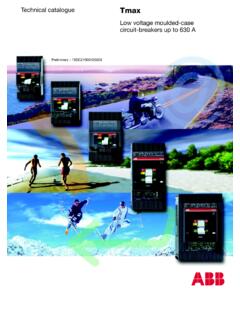Transcription of DIFFUSED AERATION DESIGN GUIDE - University of Idaho
1 DIFFUSED AERATIONDESIGN GUIDEINTRODUCTIONT hose involved in the DESIGN of DIFFUSED AERATION equipmentfor wastewater treatment should understand the impact thatprocess type, maintenance issues and economicconsiderations can have on the selection of equipment. Likemany other engineering challenges, these factors arefrequently interrelated and trade-offs of one aspect versusanother are required for most application. This DESIGN guidepresents information that has been obtained and developedfrom a variety of sources.
2 Some of this information hasbeen developed from actual test data, some is condensedfrom other published sources, some is based on goodengineering judgement and practical field experience. Theinformation, formulas, values and methods, etc. should beviewed as a DESIGN aid and may not be applicable in allsituations. The designer should always use goodprofessional engineering judgement for every following sections of this DESIGN GUIDE will brieflydiscuss the activated sludge process and biological treatmentoxygen demands.
3 The GUIDE provides a rational step-by-stepprocedure to convert actual oxygen requirements (AOR) tostandard oxygen requirements (SOR). It illustrates how toperform many of the oxygen transfer calculations includingapproximating aerator sizing and selection. Final equipmentsizing and configurations should be referred to the factoryfor must be provided in biological treatment systems tosatisfy several types of demands. These are referred to asactual oxygen requirements or AOR. AOR is alwaysexpressed as field conditions.
4 Each wastewater treatmentplant has its own unique field conditions that include siteelevation, temperature, working DO level, diffusersubmergence and alpha and beta factors. The designermust use these factors to convert AOR to standard oxygenrequirements (SOR) to properly apply the aerationequipment and determine the amount of process airrequired to satisfy the biological treatment oxygen units of expression for AOR and SOR are pounds ofoxygen per day per unit volume. SOR values will always belarger than AOR values.
5 Confusion and misunderstandingcan be minimized between designer and equipment supplierif the designer expresses his desired oxygen demands interms of SOR values. If this is not possible, then clearlyidentify the oxygen demand as an AOR value and provide asmuch information as possible for the equipment supplier toassist you in making the appropriate AOR/SOR AERATION equipment manufacturers can provideinformation to engineers and designers on the oxygentransfer capability of particular equipment andconfigurations when the equipment is aerating clear tapwater.
6 These tests, when corrected for temperature andelevation to standard conditions, become the basis fordetermining the equipment s standard oxygen requirementor SOR. Equipment manufacturers cannot guarantee theoxygen transfer capability of AERATION equipment inwastewater. Each wastewater treatment plant has its ownunique field conditions and waste type that preclude thistype of manufacturers can show engineers and designersa rational method to convert AOR to SOR and can offeradvice on the probable values used in the AOR to SORconversion.
7 However, it is the engineer s responsibility todetermine the AOR of a particular system or process andselect the appropriate conversion factors to relate AOR toSOR. Specifying an SOR value is the best way to preventconfusion and problems in the SLUDGE AND BIOLOGICAL TREATMENTA ctivated sludge AERATION tanks are the largest applicationsfor DIFFUSED AERATION equipment. These tanks and theassociated air diffusion equipment are the heart of theactivated sludge process and typically are the single largestenergy user associated with plant operations.
8 Energy costsfor AERATION will typically be 50% to 90% of all energyconsumed at a wastewater treatment must be provided in biological wastewatertreatment systems to satisfy several types of demands. Onedemand is that associated with the oxidation of organic orcarbonaceous materials. Carbonaceous oxygen demand isassociated with two cellular functions: cell synthesis andendogenous respiration. Cell synthesis carbonaceous oxygendemand occurs when organic matter is first metabolized bythe microorganisms contained in the mixed liquor.
9 It isrelated to the oxygen required to oxidize a portion of theorganic matter to provide the energy necessary for cellsynthesis. Endogenous respiration carbonaceous oxygendemand occurs as the synthesized organisms are retained inthe treatment system and it represents the essential lifeprocesses. The net result is that increasing amounts ofoxygen are required as lower process organic loadings areused. Lower process organic loadings are characterized byoperation at a longer solids retention time (SRT) and a lowerfood-to-microorganism (F:M) is also required for biological oxidation of ammonianitrogen to nitrate nitrogen.
10 If the process is designed andoperated in a nitrification mode, the oxygen demand due tonitrification must be included in the calculation of oxygenrequirements for the system. However, nitrification may alsooccur in systems where only carbonaceous BOD removal isrequired. When the wastewater is warm, say 20 C (68 F)or above, it may not be possible to operate the treatmentsystem at a high enough loading or short SRT to preventnitrification from occurring. Under these circumstances,oxygen transfer capacity to meet this additional demandmust be provided, although not required by is also required to oxidize inorganic materials in theinfluent wastewater.


